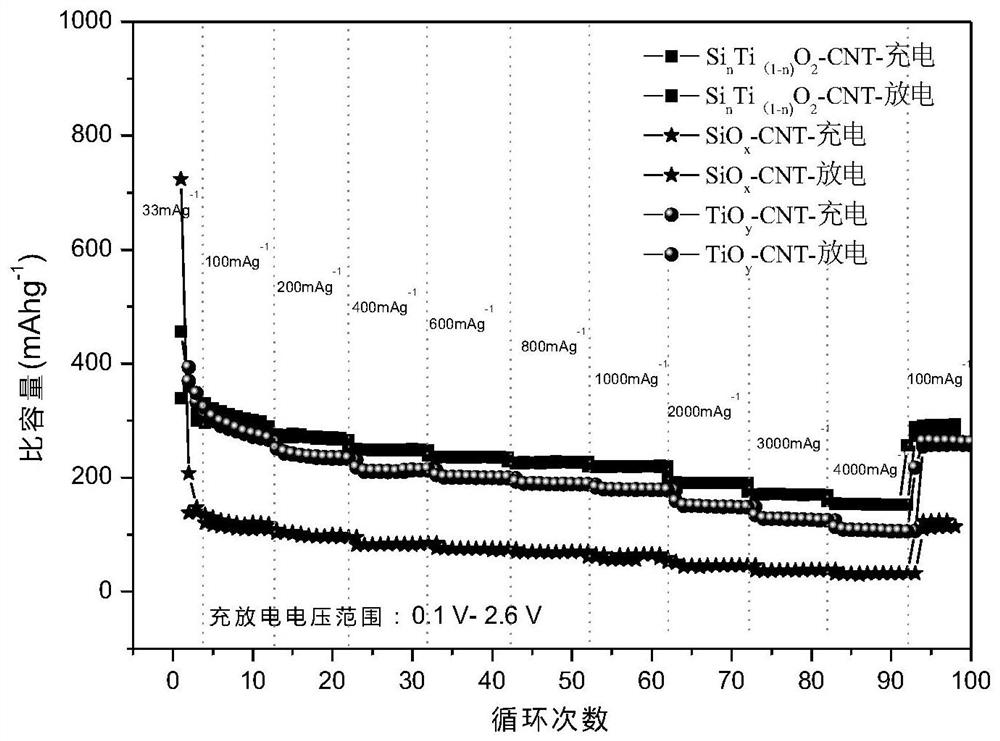Method for preparing titanium-silicon polymerized oxide composite lithium ion battery negative electrode material through thermal decomposition of organic titanium-silicon polymer
A lithium-ion battery and negative electrode material technology, applied in battery electrodes, active material electrodes, negative electrodes, etc., can solve the problems of insignificant volume change, low first charge and discharge efficiency, material specific capacity loss, etc. good performance, improved cycle stability, and excellent electrochemical performance
- Summary
- Abstract
- Description
- Claims
- Application Information
AI Technical Summary
Problems solved by technology
Method used
Image
Examples
Embodiment 1
[0030] (1) Titanium-silicon polymerized oxide Ti n Si (1-n) o 2 - Preparation of CNT lithium ion battery anode material:
[0031] Add 0.7500g carbon nanotube powder in reactor, then add the anhydrous ethylene glycol of 42.0g (as reactant and solvent in this example), stir evenly on magnetic stirrer, cover tightly reactor lining, send into the glove box. Then add 3.47g of tetrapropoxy silicon dropwise, while slowly adding, while stirring magnetically, after fully mixing, then add 10.67g of isopropyl titanate dropwise, stir while adding, and then add 0.10g cetyl dimethylamine, and finally take out the glove box under the condition of stirring evenly, and tighten the reaction kettle. Put it into a homogeneous reactor, set the reaction temperature to 140°C, take out the reactor after 6 hours of reaction, cool to room temperature at room temperature, remove the reaction mixture, wash the reactor three times with ethanol and combine the washed mixture with the reaction mixture ...
Embodiment 2
[0038] (1) Comparative material SiO x - Preparation of CNTs:
[0039] Add 0.7500g carbon nanotube powder in reactor, then add the anhydrous ethylene glycol of 42.0g (as reactant and solvent in this example), stir evenly on magnetic stirrer, cover tightly reactor lining, send into the glove box. Then add 3.47g of tetrapropoxysilane drop by drop, add slowly while stirring magnetically, wait until the mixture is uniform, then add 0.10g of hexadecyldimethylamine, and finally take out the glove box while stirring evenly , Tighten the reactor. Put it into a homogeneous reactor, set the reaction temperature to 140°C, take out the reaction kettle after reacting for 6 hours, cool to room temperature, transfer the reaction mixture, wash the reaction kettle with 10ml of ethanol three times, combine the washings into the reaction mixture, and pump The solid filter cake was collected by filtration, and the filter cake was placed in a blast drying oven and dried at 90°C. The dried mater...
Embodiment 3
[0043](1) Comparative material TiO y - Preparation of CNTs:
[0044] Add 0.7503g of carbon nanotube powder in the reactor, then add 42g of anhydrous ethylene glycol (as reactant and solvent in this example), stir evenly on a magnetic stirrer, cover the inner liner of the reactor tightly, and send it into Inside the glove box. Then add 10.67g of isopropyl titanate drop by drop, and magnetically stir while slowly adding, and then add 0.10g of hexadecyldimethylamine after mixing evenly, and finally take out the glove box after stirring evenly, and tighten the reactor . Put it into a homogeneous reactor, set the reaction temperature to 140°C, take out the reaction kettle after reacting for 6 hours, cool to room temperature, transfer the reaction mixture, wash the reaction kettle three times with 10ml of ethanol, and combine the washings into the reaction mixture. Separation by suction filtration to take the solid filter cake, put the filter cake in a blast drying oven, and dry ...
PUM
 Login to View More
Login to View More Abstract
Description
Claims
Application Information
 Login to View More
Login to View More - R&D
- Intellectual Property
- Life Sciences
- Materials
- Tech Scout
- Unparalleled Data Quality
- Higher Quality Content
- 60% Fewer Hallucinations
Browse by: Latest US Patents, China's latest patents, Technical Efficacy Thesaurus, Application Domain, Technology Topic, Popular Technical Reports.
© 2025 PatSnap. All rights reserved.Legal|Privacy policy|Modern Slavery Act Transparency Statement|Sitemap|About US| Contact US: help@patsnap.com



